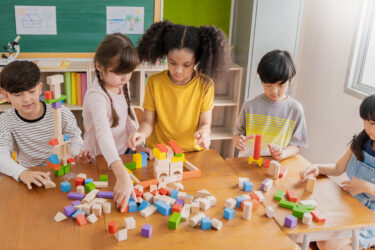Local photographers share their secrets for great kid pics.
It’s time to start thinking about the family Christmas photo! This year, you are determined things will be different. Your children will don the cutest coordinating outfits you can find. You’ve located a lovely outdoor spot and the weather is ideal. Everything seems to be going perfectly … until you decide to take the picture.
Thirty minutes and 150 shots later, you are exhausted, two of your children are crying, one stomped off in a huff and the other wants the candy you promised for being “good” during the photos. If this sounds at all familiar – have faith! We interviewed professional photographers – all with children of their own – in order to learn some tips and tricks to help you take better pictures of your kids, not only during the holidays but all year long.
Get on Their Level: Literally and Figuratively
We have been trained since birth to sit up straight, look directly into the camera and say “cheese,” but does this really give us the image we will treasure forever? Keoni K, owner of Keoni K Studio – and a father of four, suggests parents use jokes and silly sayings their children find funny. “I’ve heard parents promise everything from candy to a trip to Disney,” says Keoni, “but I like to talk with them and ask them tons of questions to find out what they like and don’t like. I laugh with them a lot and get down to their level.”
Ashley Segroves, owner of Ashley Segroves Photography in Nashville, TN says parents should give themselves enough time so they don’t feel like they are scrambling to get to their location and then in a hurry to get out of there afterward. “I find that most children respond better when they have time to take in the environment before making any pictures,” says Segroves. “Playing games will help your child loosen up and relax. A favorite song, peek-a-boo, silly smiles, a favorite toy as well as spontaneous joy are always helpful,” she adds.
Chuck Arlund of Arlund Imagery agrees. “Just play with them. Kids hate to stand still, so when you play with them, they soon forget you have a camera. You can capture them as they are naturally. Kids are real and not afraid to be themselves when you give them a chance.”
Most professionals even admit taking pictures of their own children is extremely challenging. “They know you as Daddy and Mommy,” states Keoni. “I’ve found that capturing images of my own kids is the hardest thing ever.”
It’s all About the Right Light
Ask any professional photographer the most important ingredient for a beautiful image, and they will tell you “light.” But how do you discern good lighting from poor? Arlund suggests placing your subject near a window or out of direct lighting outside. “Put the camera down and start looking at how light falls on people,” says Arlund.
Every photographer will tell you that shooting outdoors and attaining perfect light can be tricky. “During bright, sunny days, try to find a shady area to avoid squinting eyes and hot spots from the sun,” says Segroves. “If shade is not available, turn on your flash to even out the shadows and get a great highlight in your child’s eyes.”
Darker lighting in the shade can be compensated by using a make-shift reflector out of aluminum foil or a car shade to reflect light back into the face of the subject and add sparkle to the eye. Cloudy days provide nice, diffused light and are a great time to shoot. “My favorite time to shoot is right after or before a rainstorm,” Arlund adds. “The light is magical.”
Segroves says the best time of day for outdoor shoots is early morning or late afternoon, and she reminds parents to pay attention to what’s behind the subject so you don’t wind up with a picture of your child with what appears to be a tree “growing” from his head.
When shooting indoors, Segroves suggests keeping the blinds open to allow more natural light, but avoid shooting your children directly in front of the windows since most cameras expose for brightness, which will result in your child looking too dark. “If the window must be behind, turn on your flash for a correct balance of light,” Segroves says, adding, “think of creative areas – your child’s playroom, your baby’s crib, even in a highchair during dinner or in the bathtub – all of life’s moments are worth documenting!”
Great pictures don’t necessarily require an expensive SLR (single lens reflex) camera and lots of equipment. “Remember, it’s all in the eye,” says Keoni. Getting to know your camera is key. Most point-and-shoot cameras now have settings to be used in different lighting situations. Read and learn your manual to better understand what settings are best for the light you have available. The camera is only as good as the operator. The explosion of digital SLR cameras has provided amateur photographers ready access to wonderful equipment, but the person behind the camera is still key. Arlund, a big fan of point-and-shoot models for his own family photos, adds that if you use an SLR, be sure to get a good lens that will “take advantage of the camera.” His favorite is a 50 mm 1.4 lens that allows him to shoot in low light without sacrificing quality. “You have to be right on your focus, but it’s a great lens.”
Whatever type of camera you work with, Segroves suggests a little bit of experimentation to learn the ropes. “Use your flash for one picture, then turn it off in the next to compare the difference a flash makes,” she says. “Try using different combinations of light, natural, interior lights and flash to see which results are best, which will give you an understanding of your camera in advance of a big life moment.”
See the World from a New Point of View
After finding your perfect light, think about composition. A photo is a document of a moment and should tell a story. When taking a shot, stop to think about what the subject is doing; is there anything around them that could be included to help the photo tell a story?
Experimenting with different angles and backgrounds is helpful in capturing an amazing image. “Get down on your child’s level to create more of an intimate feeling,” says Segroves. “Avoid having your child stand against a wall to escape odd shadows, and make many images for variety, including far away environmental shots and tight close-ups to see all of your child’s many expressions.”
Arlund likewise suggests amateur photographers look at the world from different perspectives. “Get closer. Do some leg squats and see what the world looks like from three feet. Fill the frame of your camera. The worst thing is getting back a photo and the subject is much smaller than you remember when taking it.” Keoni suggests using the “Rule of Thirds” as a guide for taking better images. Mentally divide your image into thirds, and place your subject in one of those thirds. Sometimes an off-set subject is more interesting and helps tell the story better than one where the subject is directly centered. Don’t be afraid to try new things.
Tilt your camera for new angles, or try focusing just on your child’s hands and keeping the rest of the image slightly blurred. Arlund likes to get into the action with his kids. “Have fun and don’t think about it too much,” he says. “Don’t be afraid to get closer or walk onto the playground or climb up in a tree or on a slide. Don’t stand on the sidelines of life; get into the action. Your kids will love you for it.”
Be Prepared … and Spontaneous
Rather than trying to create the perfect picture moment with your children, perhaps a better strategy is to be ready for those spontaneous times to capture images you and your family will treasure. Arlund, who also photographs weddings, fashion and commercial images, loves taking pictures of kids.
“My favorite thing to photograph is kids, seriously,” he states. “They have no preconceived notion about a camera or looking a certain way. They are themselves, and that is awesome.” Keoni loves kids’ honesty and strives to show that in his imagery. “Kids tell the truth in their eyes,” he says. “They smile when they feel like it, and cry or get mad when they feel like it. They are the essence of truth.”
And 20 years from now, won’t those be the images that touch our hearts?
Molly Brown-Boulay is a portrait/lifestyle photographer based in Franklin, TN. She is also a mother of three children who are mostly well-behaved when getting their pictures taken.




